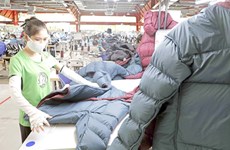Making use of ASEAN market to boost trade: radio
Vietnam considers ASEAN a big, lucrative market. However, its export
growth to ASEAN does not match potential, and anti-dumping lawsuits are
likely to occur at any time. An insight by radio The Voice of Vietnam
(VOV).
Vietnam considers ASEAN a big, lucrative market. However, its export
growth to ASEAN does not match potential, and anti-dumping lawsuits are
likely to occur at any time. An insight by radio The Voice of Vietnam
(VOV).
To fully tap this market in the lead up to the establishment of the ASEAN Economic Community (AEC) in 2015, a seminar was held in Ho Chi Minh City on May 7 to examine weaknesses and propose viable solutions.
The Ministry of Industry and Trade (MoIT) reported that Vietnam’s exports grew strongly despite the global economic crisis and domestic difficulties. The country has 22 products, 27 markets and 19 localities achieving an average export value of more than 1 billion USD each.
Export structure has shifted positively towards reducing raw products and minerals and increasing processed food and industrial products. Worthy of note is that national trade has gradually been balanced over the past two years.
Yet, Tran Thanh Hai, Vice Director of the Import-Export Department under MoIT, said Vietnam’s exports remain unstable, noting its export structure heavily relies on key products, fields and markets.
Although Vietnam is a major farm producer, it does not play an important role in controlling market prices in the global supply chain. In addition, the country’s support industry is in its infancy, the added value of industrial products is low, and trade deficit with several countries has surged.
Trade value between Vietnam and ASEAN increased four folds from 9 billion USD in 2003 to nearly 40 billion USD in 2013. The country’s exports to the regional market reached 18.5 billion USD in 2013, showing a year-on-year increase of 6.7percent while imports were 21.5 billion USD, up 2.8percent.
ASEAN is the third largest consumer of Vietnamese goods, after the US and EU. However, exports now seem to be slowing, and businesses have yet to take full advantage of incentives in ASEAN.
Huynh Van Minh, President of the Ho Chi Minh City Union of Business Association, said to realize the goal of an ASEAN Economic Community in 2015, member countries should adjust rules of origin in line with international standard to enjoy tariff incentives.
In the face of globalization, businesses have no choice but to raise competitiveness, address global challenges such as trade and investment liberalisation, tariff cuts and exemptions, streamline procedures, and form common regulations for goods.
Vietnamese businesses are advised to deeply penetrate the ASEAN market in 2014-2015, take advantage of tariff incentives in bilateral trade with Laos, and promote trade with Cambodia.
When AEC is formed in 2015, most imported products within ASEAN will enjoy tariff incentives, posing a number of challenges for Vietnamese businesses.
Vo Tri Thanh, Vice Director of the Central Institute of Economic Management (CIEM), suggested domestic businesses should be equipped with effective risk management tools, knowledge of technical barriers and macro-economic stability and policy adjustment.
They should be provided with up-to-date information and take part in the global supply chain and new, potential areas such as infrastructure development and green growth, Thanh concluded.-VNA
To fully tap this market in the lead up to the establishment of the ASEAN Economic Community (AEC) in 2015, a seminar was held in Ho Chi Minh City on May 7 to examine weaknesses and propose viable solutions.
The Ministry of Industry and Trade (MoIT) reported that Vietnam’s exports grew strongly despite the global economic crisis and domestic difficulties. The country has 22 products, 27 markets and 19 localities achieving an average export value of more than 1 billion USD each.
Export structure has shifted positively towards reducing raw products and minerals and increasing processed food and industrial products. Worthy of note is that national trade has gradually been balanced over the past two years.
Yet, Tran Thanh Hai, Vice Director of the Import-Export Department under MoIT, said Vietnam’s exports remain unstable, noting its export structure heavily relies on key products, fields and markets.
Although Vietnam is a major farm producer, it does not play an important role in controlling market prices in the global supply chain. In addition, the country’s support industry is in its infancy, the added value of industrial products is low, and trade deficit with several countries has surged.
Trade value between Vietnam and ASEAN increased four folds from 9 billion USD in 2003 to nearly 40 billion USD in 2013. The country’s exports to the regional market reached 18.5 billion USD in 2013, showing a year-on-year increase of 6.7percent while imports were 21.5 billion USD, up 2.8percent.
ASEAN is the third largest consumer of Vietnamese goods, after the US and EU. However, exports now seem to be slowing, and businesses have yet to take full advantage of incentives in ASEAN.
Huynh Van Minh, President of the Ho Chi Minh City Union of Business Association, said to realize the goal of an ASEAN Economic Community in 2015, member countries should adjust rules of origin in line with international standard to enjoy tariff incentives.
In the face of globalization, businesses have no choice but to raise competitiveness, address global challenges such as trade and investment liberalisation, tariff cuts and exemptions, streamline procedures, and form common regulations for goods.
Vietnamese businesses are advised to deeply penetrate the ASEAN market in 2014-2015, take advantage of tariff incentives in bilateral trade with Laos, and promote trade with Cambodia.
When AEC is formed in 2015, most imported products within ASEAN will enjoy tariff incentives, posing a number of challenges for Vietnamese businesses.
Vo Tri Thanh, Vice Director of the Central Institute of Economic Management (CIEM), suggested domestic businesses should be equipped with effective risk management tools, knowledge of technical barriers and macro-economic stability and policy adjustment.
They should be provided with up-to-date information and take part in the global supply chain and new, potential areas such as infrastructure development and green growth, Thanh concluded.-VNA













